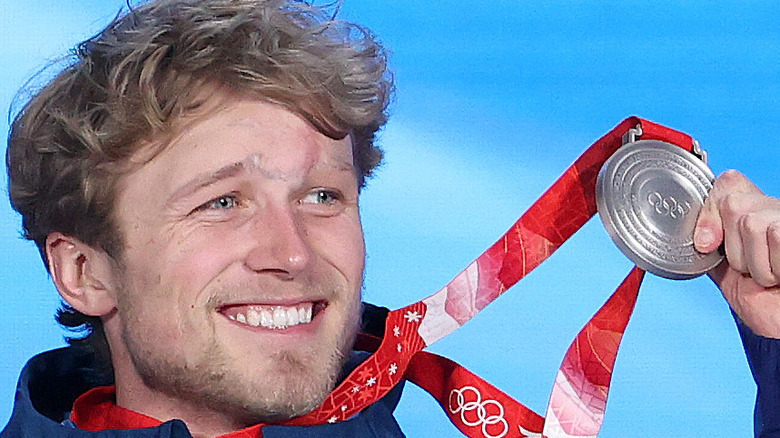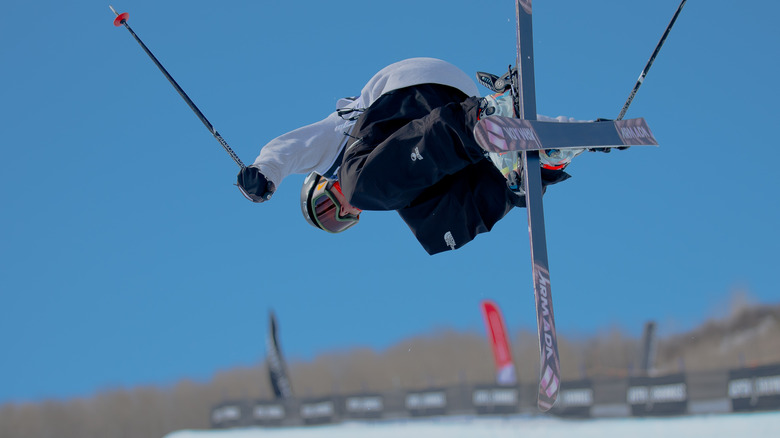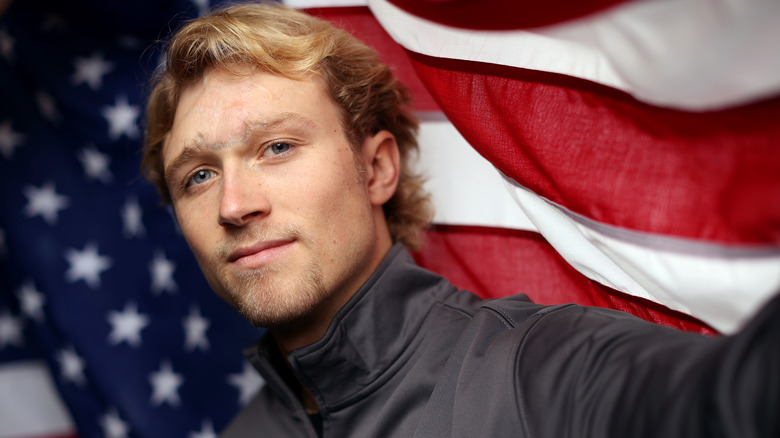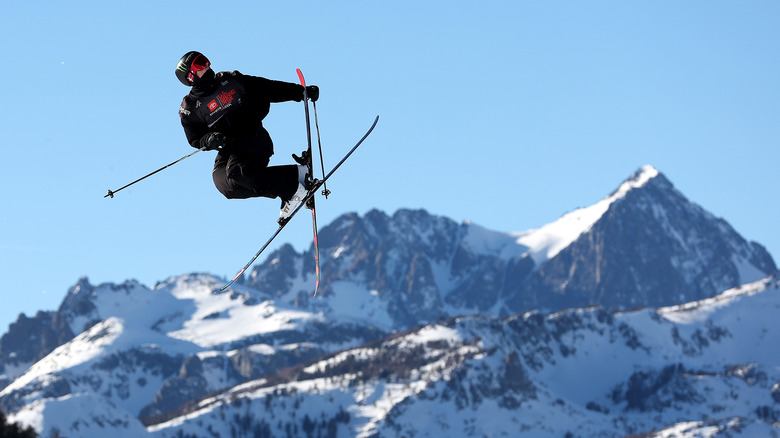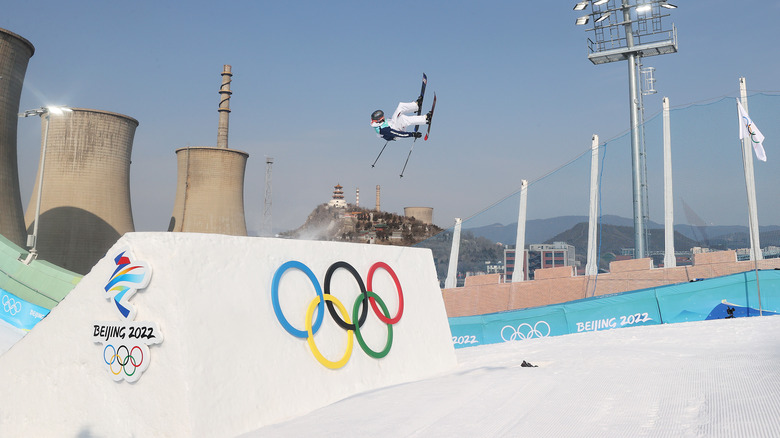The Untold Truth Of Olympian Colby Stevenson
One of the most eye-catching events at the 2022 Beijing Winter Olympics was the newly-introduced big air freestyle skiing event. While a big air snowboarding event had been included in previous Olympics, the skiing version made its debut on a purpose-built structure situated at what was formerly a smog-spewing steel mill, its once-billowing towers still visible in the background, only now featuring the colorful Beijing Winter Games logo across its drab concrete exterior (via CNN).
This setting, juxtaposed with the sight of skiers and snowboarders launching themselves off of a huge ramp, is a sight to behold, but adding to the intrigue of the event is the story of American skier Colby Stevenson. He would clinch silver in the event, an amazing achievement given the hardships he faced leading up to the games while recovering from a near-fatal car crash in 2016 that resulted in serious injuries — including 30 skull fractures (via the International Olympic Committee).
Colby Stevenson began pursuing his Olympic dream at a young age
It's a tired cliche to say that an athlete was skating or skiing or running before they could walk in but in Colby Stevenson's case, that's almost the truth. He told NBC Sports how he started skiing at a very early age. "My parents put me on skis at 14-months-old, then enabled me to try so many other sports. They've always been my biggest supporters -– even through the hardest parts, they never doubted my dreams."
Stevens was born on October 3, 1997, in Portsmouth, New Hampshire, though U.S. Ski and Snowboard lists his hometown as the skiing haven of Park City, Utah. Stevens cited the town as being integral in chasing his professional skiing career.
"Park City is a huge reason I was able to chase my dreams from a young age, having the best mountains and training facilities in the country," he said. "The high school I attended, The Winter Sports School, is the only of its kind in the country, where you go all summer from April till November," (via NBC Sports).
A car crash nearly ended Stevenson's Olympic hopes
Colby Stevenson made the United States Skiing rookie team in 2013 according to U.S. Ski and Snowboard. He would go on to place himself on the podium in both slopestyle and halfpipe competitions at the 2014 USASA Nationals.
He had a promising career ahead of him, but that was all put in jeopardy in a split-second on a dark road in rural Idaho. According to an article posted on the International Olympic Committee website, Stevenson was returning from a competition in Oregon. Fellow skier John Michael Fabrizi had broken his leg and Stevenson offered to drive his truck back home for him as they were both heading in the same direction.
Late that night, Stevenson fell asleep behind the wheel when — as Stevenson put it — "all of a sudden, boom." The truck flipped over several times, crushing its roof in the process, while Fabrizi was able to escape the crash without any further injuries, Stevenson was not so lucky.
Stevenson faces a lengthy road to recovery
The injuries Stevenson were severe. According to the IOC, he sustained over 30 skull fractures in the crash, the largest of which was situated between his eyebrows. His brain was swelling, and to combat that, doctors placed the teenage skier in a medically induced coma. The severity of his injuries left doctors thinking the odds of a full recovery — and a return to competitive freestyle skiing were slim.
Eventually, Stevenson woke up in a hospital bed. "I woke up in a hospital bed with my loved ones around me. I didn't know what happened," he told the IOC.
The severity of his injuries also left the possibility of irreversible brain damage on the table. But after expressing his apologies to his mother who had to return prematurely from a Hawaiian vacation, the family knew he'd be okay. "And so that's when they knew it was still me," he said. "They knew, then, that I was still right in my head. You know, that it was still me."
After two weeks in the hospital, he still had a long way to go before he could even consider hitting the slopes again, and this plunged Stevenson into a state of depression. "My skull was showing right through and there was this huge open wound. It was hard to look in the mirror and there were all these regrets and hindsight."
Stevenson's return to the slopes
Before Stevenson got back on his skis, he first hopped on a mountain bike which he used to explore the world he was thankful to still be living in. "Getting on the bike was huge for my mental health," he said. "Just being able to go outside and enjoy, you know, the planet," he told the IOC. "I had this newfound love. Like, just to watch a sunset was like, 'holy s***, man, like we're livin' it, you know?'"
Stevenson's first time skiing since his accident would come after just five months of recovery, but he was faced with severe vertigo and feared the inability to ever go upside-down again, a massive problem for a freestyle skier. However, he persevered and made his return to competition in 2017 in northern Italy. Not only did he compete, but he also earned his first World Cup gold medal. "It was a surreal experience; I just landed my perfect run."
X Games and Olympic triumphs
Stevenson made his X Games debut in 2020 and it garnered a lot of attention. At the event held in Aspen, Colorado, he became the first athlete to win two gold medals in their X Games debut, taking the top step of the podium in both the slopestyle and knuckle huck events (via X Games).
At the 2022 X Games, he would finish just a few places off the podium in the big air event in 6th place. That same year Stevenson qualified for the Winter Olympics in Beijing, China. His first event of the Games was big air, only this time he would earn himself a silver medal.
"So, yeah, it's been a crazy road, just, yeah, through the roof right now with excitement," Stevenson told Today. "It's still setting in right now. Big air's not my best event and to go out there and land the tricks that I had in mind and then come out with a medal is just out of this world."
